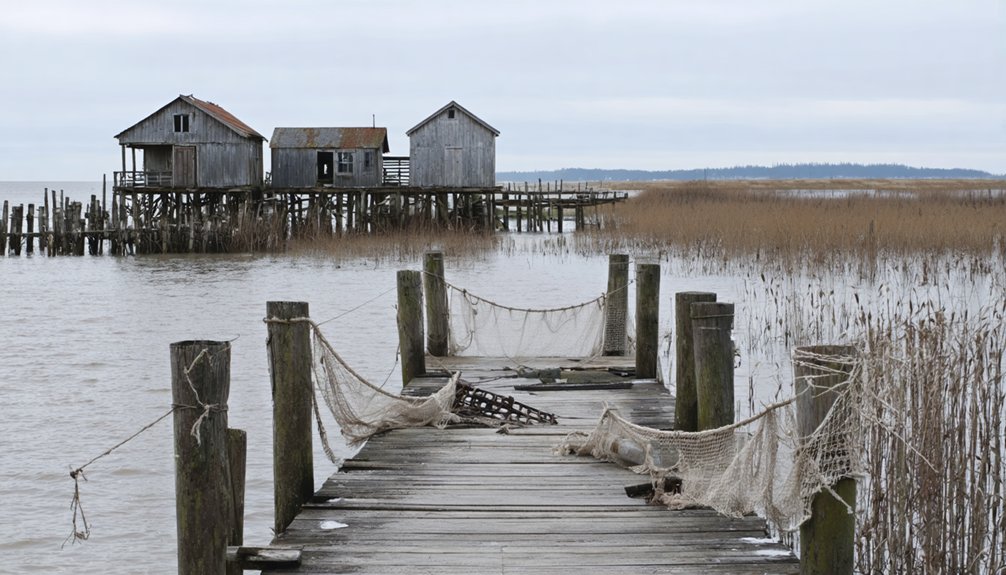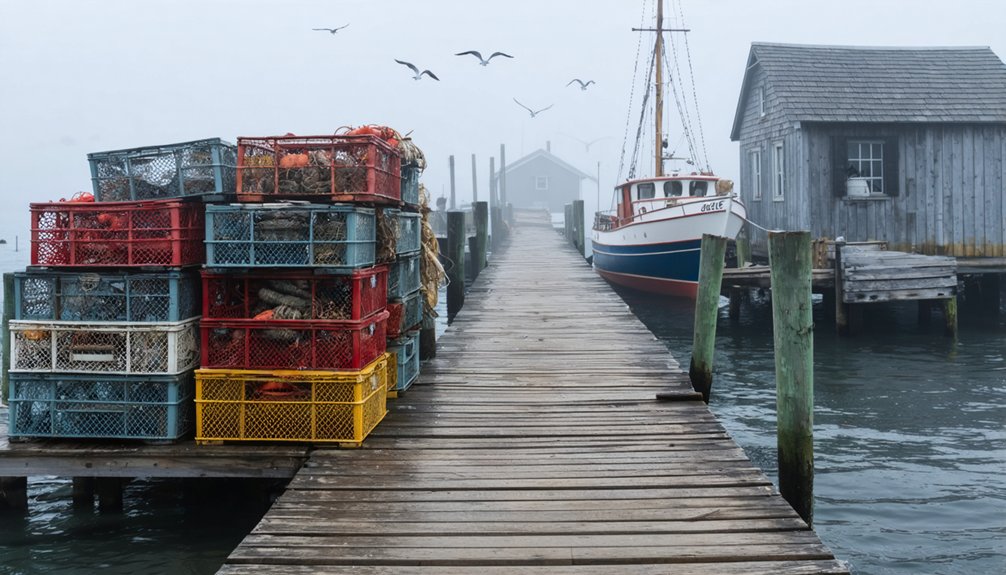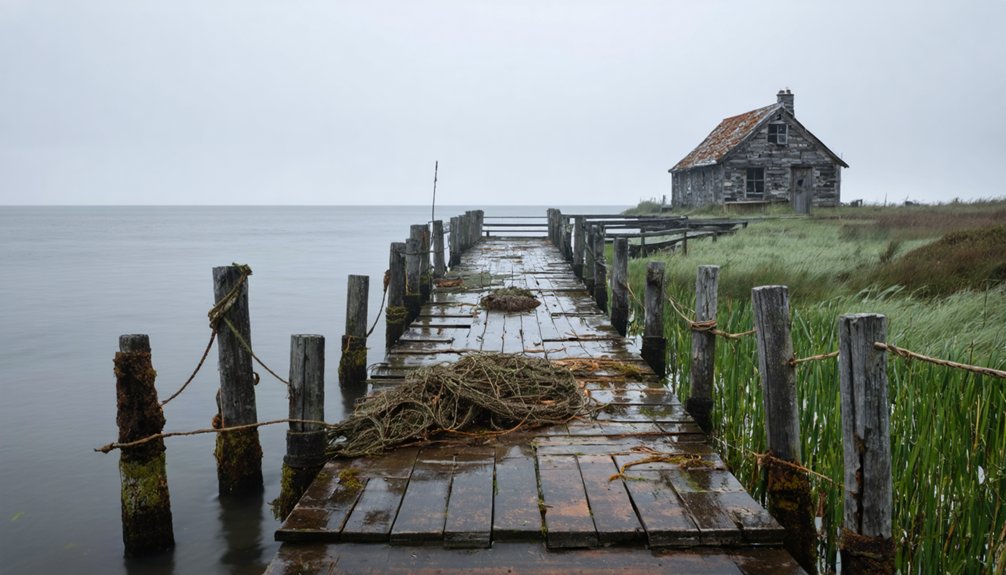You’ll discover America’s most compelling abandoned maritime communities at Bombay Beach along California’s Salton Sea, Portsmouth Village on North Carolina’s Outer Banks, hurricane-ravaged Gilchrist on Texas’s Bolivar Peninsula, Cape Lookout Village with its historic lighthouse settlement, and Salton Sea Beach’s deteriorated resort paradise. Each site tells a unique tale of humanity’s tenuous relationship with coastal waters, where environmental forces and economic tides have shaped their fates. These maritime ghosts harbor countless untold stories beneath their weathered facades.
Key Takeaways
- Portsmouth Village in North Carolina preserves 18th-century maritime heritage with historic buildings accessible only by boat.
- Bombay Beach transitions from abandoned resort to artistic community while preserving its Salton Sea maritime past.
- Cape Lookout Village features 21 structures related to maritime operations, including a historic lighthouse built in 1859.
- Gilchrist, Texas stands as a testament to coastal vulnerability with just one house surviving Hurricane Ike’s destruction.
- Salton Sea Beach showcases abandoned marinas and waterfront properties from its heyday as a celebrity-frequented resort destination.
Bombay Beach: The Haunting Shores of California’s Salton Sea
Along the southeastern shore of California’s accidental sea lies Bombay Beach, a maritime community that stands as a stark reminder to the impermanence of human ambition.
Once a thriving 1950s resort where vessels skimmed azure waters and anglers pursued prized Corvina, nature’s wrath intervened. Cyclonic floods in 1976 submerged structures while agricultural runoff poisoned waters, driving salinity to toxic levels. The protective berm proved insufficient against environmental decay, as marinas crumbled and fish perished.
Paradise drowned not by fate but by human negligence, its azure waters now a toxic tomb.
You’ll witness today a paradoxical renaissance. Wooden skeletons of former docks and salt-crusted shores now serve as canvas for artistic transformation. The Bombay Beach Biennale, first held in 2015, celebrates this artistic revival through installations and performances. Bold sculptures and installations emerge from wreckage, creating an otherworldly gallery where freedom-seeking visitors contemplate humanity’s relationship with water.
This nautical graveyard, with its sulfurous breeze, offers profound lessons in resilience. The community now focuses on habitat restoration through ambitious wetland projects aimed at mitigating dust and revitalizing the ecological landscape that surrounds the diminishing shoreline.
Portsmouth Village: North Carolina’s Preserved Coastal Ghost Town
While California’s Salton Sea offers glimpses of aquatic abandonment, the Atlantic coast harbors its own maritime ghost—Portsmouth Village. Established in 1753, this once-bustling North Carolina port flourished until changing shipping routes and Civil War disruption eroded its foundation.
You’ll discover a pristine capsule of Portsmouth history when you visit this remote Outer Banks settlement. The National Park Service preserves its weathered clapboard structures, windswept cemeteries, and the 1915 Methodist church—all symbols of resilient maritime culture. Visitors can explore the historical Theodore and Annie Salter House which now serves as a visitors center for tourists. The village’s architectural landscape includes distinct story-and-jump houses with their characteristic one-and-a-half stories, gable roofs, and wooden frames.
At its 1860 peak, nearly 700 residents called Portsmouth home before hurricanes and economic decline gradually emptied the village. The last inhabitants departed in 1971, leaving behind a hauntingly beautiful landscape accessible only by boat—where freedom-seeking travelers now walk silent paths once trodden by lighthouse keepers, fishermen, and coastal traders.
Gilchrist, Texas: A Hurricane-Ravaged Gulf Community Frozen in Time
Nestled on the vulnerable Bolivar Peninsula, Gilchrist once represented the tenacity of Gulf Coast maritime settlements until Hurricane Ike‘s devastating 2008 landfall transformed it into a haunting memorial to nature’s power.
Named for engineer Gibb Gilchrist, who rebuilt rail infrastructure after the 1915 hurricane, this early 20th-century shipping community embodied coastal resilience through its strategic positioning between Galveston Bay and the Gulf.
You’ll find little remaining of Gilchrist’s pre-Ike population of 1,000; nearly every structure succumbed to catastrophic storm surge. The displacement of residents mirrors experiences of communities inundated by the Toledo Bend Reservoir in the 1960s. Local experts now help visitors unlock the ghostly past of this and other Gulf Coast communities through guided historical tours.
A solitary surviving house stands sentinel, symbolizing both human vulnerability and defiance against natural forces.
The ghost town’s barren stretches now serve as sobering classrooms for coastal vulnerability studies, while maritime enthusiasts trace the vanished contours of a once-thriving peninsula outpost.
Cape Lookout Village: The Abandoned Lighthouse Keepers’ Settlement
Hidden on the isolated Core Banks of North Carolina, Cape Lookout Village stands as a maritime ghost town that once supported the essential navigation aid of the Outer Banks. As you explore this abandoned settlement, you’ll discover 21 historic structures surrounding the iconic lighthouse, first authorized in 1804 and rebuilt in 1859.
The village reveals the challenging reality of lighthouse history through its keeper’s quarters, Coast Guard station, and fishing cottages—now weathered by time and sea air.
Lighthouse keepers endured coastal isolation while maintaining the crucial beacon, working rotating shifts that allowed for family life amidst maritime duties. They cultivated self-sufficiency, growing gardens and raising livestock on the sandy terrain.
Today, these remnants rest under National Park Service protection, largely abandoned but preserving the legacy of maritime workers who once called this remote outpost home.
Salton Sea Beach: From Resort Paradise to Desert Ruin
Among California’s most peculiar maritime oddities, Salton Sea Beach emerged from an engineering catastrophe that permanently altered the Colorado Desert landscape. When floodwaters breached irrigation canals in 1905, they created an accidental inland sea that enterprising developers quickly transformed into a thriving resort destination.
You’ll find the skeletal remains of this mid-century playground haunting the shoreline—abandoned marinas and decaying vacation homes that once bustled with anglers and sun-seekers.
The Salton Sea’s promise capsized under increasing salinity and agricultural contaminants by the 1970s, creating an ecological disaster of unprecedented scale. Fish populations collapsed while toxic dust from exposed lakebed now threatens surrounding communities. The beachfront, once pristine, is now covered with crushed fish skeletons that crunch underfoot as visitors explore the area. During its prime, the area attracted notable visitors including Frank Sinatra and celebrities who sought recreation in this desert oasis.
A paradise drowned by human negligence, where the stench of dead fish mingles with the ghosts of forgotten leisure.
What remains is a maritime ghost town where the freedom of open waters has surrendered to environmental ruin.
Frequently Asked Questions
Can Visitors Legally Explore These Abandoned Maritime Communities?
You can explore most abandoned maritime communities legally, but you’re bound by visitor regulations and may need exploration permits for protected sites. Always verify local restrictions before starting.
What Safety Hazards Exist in These Deteriorating Coastal Sites?
You’ll encounter treacherous structural instability, rusting structures that may collapse without warning, unstable terrain, toxic chemical exposures, submerged hazards, and environmental contaminants including asbestos and petroleum products when traversing these maritime ruins.
Are There Ghost Stories or Paranormal Claims Associated With These Locations?
You’ll encounter abundant paranormal claims at these locations—ghost sightings of former residents haunt weathered structures, while paranormal investigations document EVPs, unexplained lights, and spectral apparitions along these forsaken maritime thresholds.
How Has Climate Change Affected These Abandoned Coastal Settlements?
You’ll observe rising tides decimating historic wharves and coastal erosion undermining foundations of maritime structures. Sea-level advance claims these settlements incrementally, with storms accelerating the reclamation of once-thriving seafaring outposts.
What Belongings or Artifacts Were Left Behind by Former Residents?
Like digital breadcrumbs of the past, you’ll discover historic relics including navigational instruments, fishing apparatus, and deeply personal items—photographs, letters, kitchenware—abandoned during hasty departures from these weathered maritime sanctuaries.
References
- https://www.loveexploring.com/gallerylist/131658/abandoned-in-the-usa-92-places-left-to-rot
- https://www.youtube.com/watch?v=vjuPNA_vzQs
- https://wicproject.com/travel/10-abandoned-seaside-places-in-america-that-were-once-tourist-hotspots/
- https://en.wikipedia.org/wiki/Wikipedia:WikiProject_Ghost_towns
- https://listverse.com/2019/07/28/10-abandoned-settlements-which-are-now-underwater/
- http://ndl.ethernet.edu.et/bitstream/123456789/15853/1/76.pdf
- https://www.geotab.com/ghost-towns/
- https://devblog.batchgeo.com/ghost-towns/
- https://en.wikipedia.org/wiki/Ghost_town
- https://en.wikipedia.org/wiki/List_of_flooded_towns_in_the_United_States



